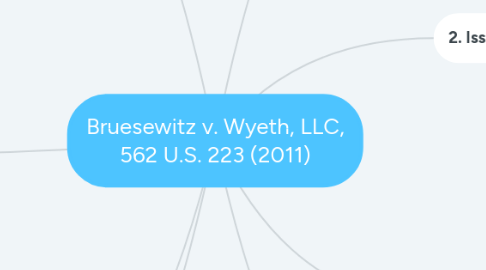
1. 3. Rule of Law
1.1. National Childhood Vaccine Injury Act (1986)
1.1.1. Provides vaccine manufactures with tort liability protection.
1.1.2. Reduce the financial liability of vaccine manufacturers from the vaccine injury claims.
1.1.3. Protect vaccine manufactures from liability that the vaccines are unavoidable and adverse side effects once they met the regulatory requirements
1.2. Strict Product Liability
1.2.1. Products must not be dangerous from manufacturing process, design defect, and inadequate warning
2. 4. Analysis/ Application
2.1. Wyeth, LLC
2.1.1. Argues that the purpose of the NCVIA is to prevent vaccine manufacturers from the financial liability
2.1.1.1. "The section exempts vaccine manufacturers from civil liability for unavoidable vaccine-related injuries or death as long as the vaccine was properly prepared and adequately labeled." 42 U.S. Code 300aa-22(b)(1)
2.1.2. Vaccine is recommended by the CDC, which is under a protection of NCVIA. They have mentioned the seizures as one of the possible side-effect of the drug that they have followed the regulatory requirements.
2.2. The Bruesewitzes family
2.2.1. Focused on the word "unavoidable" that saying the law protects the manufacturers only when a vaccines' side effects had no other ways to design it to lower the risk. The bruesewitze family argued that there was a possible replacement for this vaccine.
2.2.1.1. Wyeth argued that NCVIA not only to compensate vaccine victims for their suffering, but also reduce the financial litigation for the vaccine manufacturers.
2.2.1.2. Wyeth argued back that the law is protecting all terms against all possible design-defect claims. And said the Bruesewitzes family relies on an erroneous treatment of the term unavoidable.
2.2.1.3. Certain side effects will be always there in any kinds of medication and consumers need to decide whether they want to use it or not. In addition, the seizures was on the list of the side effects of vaccine that Hannah had that manufacturer does not have evidence of violation of regulatory requirements.
3. 5. Conclusion
3.1. The Supreme court affirmed the lower's court judgement.
3.1.1. Decision was made under the NCVIA, for the Bruesewitz's claim against Wyeth, LLC for the compensation.
3.1.1.1. This decision made all the manufacturers protect from the liability as long as they have met the regulatory requirements.
4. 7. Importance
4.1. This NCVIA act really showed the protection to the manufactures in the drug/ vaccine industry as long as they followed the regulatory requirements. Thus, this case not only shows the protection to the manufacturers, but also alarm the industry of how important to keep the regulations in order to avoid any claims and litigation.
5. 1. Facts
5.1. Parties
5.1.1. Bruesewitz Family - Plaintiff
5.1.2. Wyeth, LLC - Defendant
5.2. What happened
5.2.1. The daughter of Russell and Robalee Bruesewitz, Hannah was 6 months old, she received the vaccine called DTP, which was manufactured by Wyeth, LLC on April 1, 1922.
5.2.1.1. She had to suffer from Seizures short time after she got the injection and during 16 days, she had to suffer total 126 seizures from this vaccine's side effect.
5.2.1.1.1. Due to this side effect of DTP, Hannah will have to require medical care for lifelong period.
5.3. Procedural History
5.3.1. The Bruesewitz filed a suit against the US court of Federal Claims under the National Childhood Vaccine Injury Act (NCVIA), however the claim was denied.
5.3.1.1. The Bruesewitz family filed a suit against Wyeth, LLC under strict product liability. However, the US court favor of Wyeth by the NCVIA.
5.3.1.1.1. The Bruesewitz appealed to the Supreme Court.
6. 2. Issue
6.1. Legal principle/ precedent
6.1.1. Whether Wyeth, LCC is liable for vaccine's side effect by Hannah's case? Whether Hannah should get compensation from suffering from her medical injuries from the DTP vaccine?
6.1.2. Whether the National Childhood Vaccine Injury Act provides shield for the drug manufacturers from the liability suit due to injuries or side effect caused from the vaccines?
6.1.3. Whether State and Federal court can protect the vaccine manufacturers from tort actions filed in and look for compensations from the injuries?
7. 6. Impact
7.1. Sebelius (Health and Human service) v. Cloer
7.1.1. Cloer began to suffer from multiple sclerosis diagnosis after she had a hepatitis-B vaccine.
7.1.1.1. Cloer found out that her diagnosis came from the vaccine that she had. Filed a claim for NCVIA.
7.1.1.1.1. The court ruled in Cloer's favor because her symptom started right after the vaccine and NCVIA had a limitation of 36 months period.
7.2. Ferriari v. American Home Products Corporation
7.2.1. The son of Ferrari suffered neurological damages after he had a vaccine.
7.2.1.1. Decision was made under NCVIA by there were no evidence of the manufacturer for a product liability.
7.3. Multiple case v. HHS
7.3.1. Because of enable of NCVIA act, there were many cases that defendant were paid compensation.

